A nine-night visit to Andalucia with Martin Garwood, Chris Roome and Mike Copland. We stayed at three different centres, which worked well, and employed professional guides on two days. The weather throughout our stay was very hot (up to 35°C) and mostly sunny, though with strong winds at Tarifa. We missed few of the birds we might have expected to see, while finding Rüppell's griffon vulture and both little and white-rumped swifts was a bonus. I had never seen either the vulture or white-rumped swifts in Europe before. Our final group total was 158 species. Butterflies were poor, but we did manage to see a single monarch.
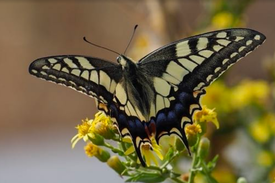
Stansted at 5am is a horrible place. The airport seemed exceptionally crowded - there was hardly a seat to be found - but we were soon called for our flight, which took off on time and arrived in Seville early.
Finding the hire-car courtesy bus was a minor challenge and it took some time to get the car. The big excitement here was a large raptor spotted by Chris. I only saw it briefly, but it’s large size drooping primaries suggest that it was a juvenile imperial eagle, as did its plumage, with notable white rump.
We stopped at Aldi in Marchena for a quick shopping expedition, then carried on towards the great bustard zone (i.e. the Osuna area). It was very hot (33°C), but the sky was rather hazy. Through we found birds in the rolling cereal-growing area, we failed on any steppe species. The landscape was parched, though there were a few puddles. Crested larks and stonechats were common, and we saw a good number of spotted flycatchers, as well as a few warblers - Sardinian, willow and best of all, olivaceous, though the latter is now called isabelline warbler. There were raptors, too, though most turned out to be buzzards, plus an immature marsh harrier. Other birds seen included Spanish sparrows, corn buntings, a few linnets and goldfinches, a single whinchat, blackcap, blackbird, one yellow wagtail, several ravens and lots of spotless starlings. Butterflies were few, with a couple of probable Bath whites and two swallowtails. Interestingly, we met a young Italian couple who were also birdwatching. They had been to Doñana but said it was very dry, while they had suffered from strong winds at Tarifa. We continued on to Osuna, then south-west through the mountains to Montecorto, stopping briefly to watch a soaring golden eagle, a very showy and handsome young bird. We soon found our accommodation in Montecorto, a three-storey town house, El Mirador
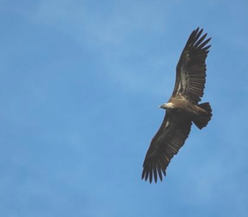
I woke at 3.15am and felt rather pleased to hear a tawny owl. Martin did rather better, both hearing and recording an eagle owl and a little owl. Frustratingly, the eagle owl was never heard again.
Sunrise wasn’t until well after 8am, so by the time we left it was still quite cool. We took a rural road through the cork forest to Grazelema, with our first stop producing a variety of new birds, most of which were heard rather than seen. Blue and great tit, chaffinch, nuthatch, jay, Iberian green woodpecker were all noted, while a small group of woodpigeons were spotted high on a tree warming in the early morning sun.
Our next stop was close to a large and impressive cliff face close to Grazelema. The first good bird was an Iberian grey shrike, warming up in the sun, but we soon saw and heard our first choughs, their wonderful calls so evocative of sites such as this. Stonechats were common, and we also saw Sardinian warblers and once a melodious warbler, but our first rock buntings were very distant. Mike spotted a group of griffon vultures waiting in the sun for the first thermals, while I found an ibex that no one else saw. Butterflies offered a diversion, with wall browns, southern grizzled skippers and southern common blues.
We then dropped down into the valley where a small water-treatment plant’s settling pools offered a different habitat. There were lots of warblers here, but they were mostly elusive, though I photographed a small group of smart young chiffchaffs feeding by the side of the road. White wagtails were numerous, and a grey was also noted. Our first short-toed eagle was seen high overhead.
After a false start (though we did manage to refill our big water bottle from a spring) we climbed up to the Puerto de las Palomas (Pass of the Pigeons), but apart from a few griffons and high hirundines we struggled for birds. The far-reaching views, however, were superb, and we did see blue rock thrushes, while Mike surpassed himself with finding a pair of black wheatears. Martin and I missed them as we were then back at the car. We then wound our way down to lower altitudes and made our way back to base for lunch and a siesta. At 4pm we set off for Ronda, a large and challenging town to drive through. We eventually found the historic centre and drove across the old bridge, but it was packed with people and parking was nearly impossible. So, we finished our afternoon by driving south through the mountains on the Algeciras Road, stopping at various miradors. We did see birds: big numbers of migrations hirundines, with our first red-rumped swallow. Distant black wheatears were enjoyed, but birds were generally few as the ground was parched and arid. We didn’t even manage a Thekla’s lark. Again, though, the scenery was superb, and we enjoyed a picturesque drive home.
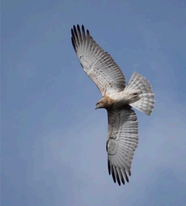
No exciting owls in the night. We set off shortly after 9am for our morning’s excursion, enjoying the brief period of cool temperatures before the sun had risen in the sky. We made two or three stops in the cork-oak woods finding our first pied flycatcher, shortly followed by a pair of firecrests that showed well. A great-spotted woodpecker flew over, nuthatches were seen, along with blue and great tits. We continued to the valley below Grazelema with the water treatment works, and here we enjoyed great views of blackcaps, saw another grey wagtail along with numerous white wagtails. A hawfinch flew over and turned out to be one of a flock of perhaps nine or ten birds. None showed particularly well (no chance for photographs), but we enjoyed seeing them. As we drove out of the valley, we stopped for a blue rock thrush posing on a rock: there were two birds, one an immature male, the other a full adult. Martin and I took some pleasing pictures.
We then took the road to Ubrique, with our first stop overlooking an extensive flat grazed area. Here the first new bird was a mistle thrush: there were four or five of them. A Dartford warbler showed well close to the road, while an unseen bird with a dry rattling song confused us. We eventually saw it, and it was of course a cirl bunting. Griffon vultures were now circling in numbers over a nearby ridge, while an unseen woodlark was singing close by. We also saw a perched northern wheatear. Hairstreak butterflies were flying around the ilex oaks. These were presumably ilex hairstreaks, but according to the books there is only one brood that flies from May to late July. Curiously, no hairstreaks are noted as flying in October.
A little way farther on we stopped at an attractive wooded site with picnic tables where we enjoyed watching (and trying to photograph) a pair of pied flycatchers. Here a tired-looking great banded grayling was new for the list and was the only one seen during the holiday. Our route took us on through a deep but wide gorge - we paused briefly for a black wheatear close to the road. The scenery was spectacular, but the birds were few. There were no raptors other than a few griffons, while the only birds to photograph were Sardinian warblers. We paused in Ubrique for coffee, or in my case a cheesecake. House sparrows clustered round our table, including an interesting bird with white in its primaries.
On the way back we paused to look over the reservoir in the valley below Montecorto. The level was desperately low, while there was not a single water bird of any description to be seen. After our late lunch and siesta, we drove out again, covering a loop of rolling agricultural countryside behind Montecorto. As usual, the scenery was spectacular, but we saw some birds, too. We had fine views of alpine swifts, high overhead, and apparently moving south with house martins, while we also saw a short-toed eagle. There were lots of griffons, as usual, with many sitting in trees, as if waiting for something to happen. We were also entertained by a number of paragliders, flying at great altitudes with the vultures. At the high point of our drive, we came to the ruins of ancient Ronda (Ronda la Vieja), a protected archaeological site. Here there were scores of corn buntings resting in the tangle of brambles below the summit.
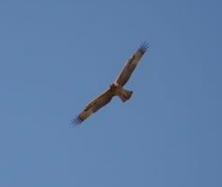
We were packed and on the road before 9am. I chose to drive on the main road to Arcos de la Frontera, so we didn’t take long to get there as the road was fast with little traffic. We soon found the reservoir, which I couldn’t remember at all from my last visit, as it is now a public recreation area, with fishing and even paddle boarding. There were few birds. Initially all we found were Muscovy ducks and a few domestic mallard and waxbills, the latter feeding in the trees close to the banks. We did add black headed gull, great-crested grebe and coot, while Mike and I saw a spoonbill drop into the extensive reedbed, but it wasn’t good birdwatching. We eventually added serin (heard but not seen), plus marsh harrier and a distant soaring booted eagle (we were to see a much closer booted eagle from the car as we drove out of Arcos.) I managed to find the road below Arcos that gave us a fine view of the famous Arcos cliffs, and here we enjoyed great views of a small male peregrine.
From Arcos we drove south to Medina Sidonia on a remarkably smooth road that must have been finished a few months ago, but in contrast in Medina we crawled through the town on the same old narrow roads that have been unchanged in decades (Note - this was an unnecessary detour as there's now a ring road by-passing the town but older sat navs seem not to have been updated - JC). We soon found the Valcargado track that John Cantelo recommended, a broad, well-graded but very dusty sand road that took us deep into the rolling countryside past a few rather grand country houses. (Note - grand and with an interesting history as Valcargado finca was often visited by Ernest Hemmingway and later Orson Welles - JC) We stopped for our lunch not far from the end of the track and had scarcely taken the first bite before a fine juvenile Bonelli’s eagle appeared over the ridge to the north of us, soon followed by a juvenile Spanish imperial eagle from the same direction. Both gave prolonged and good views, though mainly at long range (at least for photography). We had fine views of another imperial eagle but didn’t see another Bonelli’s. It was hot and sunny, as usual, but there was a very strong and gusting wind that made conditions less than pleasant. Buzzard, kestrel and griffon vulture were added to the raptor list, and we also saw red-legged partridges, but not much else, possibly because it was too windy.
It was then just a short drive to the coastal town of Barbate. We approached past the cliff where the bald ibises nest, then drove across the bridge with the extensive marshes to our left, the sea to the right. It was brilliantly sunny, but horribly windy. Out to sea we saw our first gannets, while the big gulls loafing on the spit were all yellow-legged. A whimbrel, a flock of turnstones and a single ringed plover were our first waders of the trip. Looking out over the marismas, we saw very distant flying bald ibises.
We continued along the road between the sea and the marsh - I overshot the turn I wanted to make, so we turned round, came back, and drove off road to the edge of the marismas. Here our first stop was close to a pool crowded with a variety of waders - stilts, dunlin, little stint, curlew sandpiper, ruff - while farther out there were many more waders to see, along with flocks of flamingoes. Two of the latter were pronounced to be dead, but they were simply having a snooze on the mud. There were lots of good birds to be seen. We soon added osprey to the list (a bird with a fish, when it flew it took its fish with it, leaving a disappointed gull behind), plus avocet, black-tailed godwit, redshank and a large flock of resting Audouin’s gulls. However, that horrible wind made it difficult to use the telescope and took away much of the fun.
We all felt tired and sun- and wind-battered, so we decided to head for our new base in Tarifa (Hotel La Torre) an easy drive past the hundreds of wind turbines. We were delayed briefly by an accident that had happened (fortunately) some time before, with a rolled and destroyed 4x4 upside down in the ditch. (It remained there for the next two days).
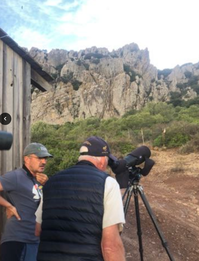
7th October
We eventually got away not long after 8.30. Our guide, Javi Elorriaga, from Birding the Strait (www.birdingthestrait.com) proved to be a likeable chap in his 40s, originally from Bilbao and with a Belgian wife.
He certainly knew his birds and how to find them, taking us first to the cliff face (Laja de la Zarga, Bolonia - JC) where scores of griffons roost and a number breed. He soon found us a Rüppell's, an immature bird standing on a ledge next to a standard griffon which allowed us to compare the two. The former was distinctively darker headed, and quite clearly a different species, though its slightly smaller size wasn’t obvious (NB - although texts often suggest that smaller size is a distinguishing feature of Rüppell's there is a considerable overlap in size with griffons - JC). We watched it for some time before it finally launched itself off, soaring high above us. I took a number of photographs, but the light was poor, and none were worth keeping.
We then climbed back into Javi’s small Renault van and drove for about 20 minutes up to Tahivilla and then La Janda (seeing a red kite en route), where before long we had our first rather brief glimpse of a black winged kite. The strong wind made it more challenging to see, but we eventually found it again and enjoyed great views of it, although at some range. A delightful and entertaining bird, and a lifer for Chris and Mike. (I had seen my first near Badajoz in 1964). Here we also saw a pair of stock doves, apparently rare birds in Andalucia. A number of distant booted and short-toed eagles were also seen, but no harriers other than a marsh - this is apparently prime harrier country.
We then drove south, pausing in Tarifa to buy sandwiches and trying to see the world’s loneliest bulbul that lives there - we failed. We then drove along the busy coast road towards Algeciras, turning round then stopping at a raptor watchpoint with a backdrop of Gibraltar. Here a couple of professional watchers were already in place. We saw numerous griffons, booted and short-toed eagles, but all at long range. As we left a juvenile Bonelli’s eagle flew over, but by the time we saw it was all but impossible to identify. Apparently Bonelli’s are often identified because of the reaction of other birds to them, as they are regarded with fear. The wind remained too strong for the raptors to be able to cross the Strait.
Our next stop took us back much closer to Tarifa on the south side of the road, driving through a crumbling tarmac road through a derelict army base, eventually ending up with commanding views of the Strait (Observatorio de Guadalmesí - JC). It was very windy, and we didn’t see a great deal here, other than a single black kite and an unexpected juvenile honey buzzard, an extremely dark individual that, without Javi’s expertise, would have been tricky to identify. We returned to the main road, pausing for coffees and/or ice creams at a rather scruffy cafe (Mirador de Estrecho - JC) with an impressive view. Then it was back across the road, into the natural park, travelling on a rough but well graded dirt road. We gathered from Javi that this is a classic roosting site for short-toed eagles that bottle-up here when they are unable to make the crossing. We then had a fascinating hour watching these impressive and beautiful birds, mainly from above, as they landed in the trees below us. We gathered that breeding birds from southern Italy and even Croatia will cross here every year, rather than risk the longer crossing from Scilly to Libya.
Apart from the snake eagles there were also a number of booted eagles, and we also saw two hobbies (or perhaps the same bird twice), along with a number of sparrowhawks. It was an attractive drive which we much enjoyed.
We finished the day with an abortive search for monarch butterflies, but our efforts were rewarded with the sight of a flock of around 30 black kites high overhead, one of the very last migrant kite flocks of the year. We had seen 16 species of raptor, including all three kites, while we hadn’t expected honey buzzard or black kite as they should have all gone through. A memorable day.

Though this was a second guided day in a row, it was quite different in many ways from yesterday. Our guide, Manuel Morales from Birding Tarifa (www.birdingtarifa.com) is quite a different character than Javi yesterday, and rather more fun. He arrived five minutes early (our breakfast was rather slow as usual), but we were soon off in his spacious VV minibus for our first destination, the old Martello tower on the headland south of Zahara, the Cabo de Gracia. The sky and the sea were both a rich shade of blue, and though we were partly sheltered from the wind it was still fierce. It was challenging seawatch, as most of the birds were well offshore.
A number of Cory’s shearwaters were eventually spotted passing distantly, and we did see two Balearic shearwaters, but passage was light. Gannets were more numerous, and once we saw a flock of a dozen spoonbills heading south along the coast. A couple of Sandwich terns were noted, but no skuas. In many ways more interesting than the seabirds was the steady passage of hirundines moving south. These included sand and house martins, as well as swallows, but red-rumped swallows were the most numerous. We had only just set off when Manuel spotted a couple of swifts flying above the road - little swifts. We jumped out and enjoyed watching these delightful birds. I saw two but the count was five individuals.
Our next stop was the marshes at Barbate, which we entered at exactly the same place as we had done 48 hours before. There were all the birds we had seen before, plus a couple of lapwings, but despite trying hard we failed to find stone curlews. There was a party of ex-pat birdwatchers, led by a jovial chap called Peter Jones, already there, and they had recorded 56 species for World Birdwatch Day. We didn’t see nearly as many, but we enjoyed a trio of bald ibises feeding in one of the scruffy and crowded cattle enclosures, in company with scores of feral pigeons, a few corn buntings and a single hoopoe. They were tame and took little notice of us. Next Manuel promised us imperial eagles, but en route on the A396 he spotted a pair of swifts over the road. He did a quick U-turn, managed to park the van, and relocated the birds which hawked over our heads for the next few minutes. They were white-rumped swifts, a bird first found nesting in Spain (and Europe) for the first time in 1967 by an Englishman called Geoffrey (FGH) Allen. I had stayed with Geoffrey in October 1968 at Los Barrios, in his house close to Gibraltar. This was my first sighting of Apus caffer in Spain, so a satisfying moment. Before our eagle hunt, we stopped at a roadside venta ... as we ate on the terrace, I saw short-toed eagle, marsh harrier, red kite and a possible (if not probable) lesser kestrel.
Our search for the eagle took us back along the Valcargado Track we had driven along on Thursday, and which I now recognised as the one Rocio had taken us along in April 2019. We had reasonable views of juvenile imperial eagles, but the adults were more elusive and viewed only at great range.
Then it was on to La Janda, driving first past an extensive and hugely intensive plantation of olive trees, not a fine advert for the EU’s Common Agricultural Policy. We paused briefly to admire a herd of toro bravo, though they were mainly cows, then stopped to watch a delightful young Montagu’s harrier hunting along a waterway. Scores of corn buntings rose from the fields, and we saw several flocks of calandra larks, too. Our final stop of the day was at a couple of flooded rice fields, and here there were lots of birds to see. Most obvious were the hundreds of glossy ibises, but there were also white storks, lapwings, a few ruffs, ringed plovers (and also one little ringed), our first wood sandpipers, a few green sandpipers along the ditches, stilts, snipe, a kingfisher and a bluethroat, though the latter were only glimpsed. A pair of ortolans buntings, spotted by Manuel, came into the latter category. A large flock of calandra larks stopped and circled over one of the paddies. We had been promised hen harriers, and though we missed seeing a cock, we did see three different females. It was a great way to finish the day, with nearly 90 species in the bag. We didn’t get back until after 7pm - a long day.
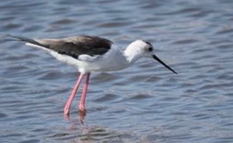
9th October
Our last morning in Tarifa, so we ventured out first thing to check the beach. Tarifa’s beach is a magnificent five-mile long broad band of sand, so is attractive to birds, but even more so to humans. Disturbance is such that even in the early morning few birds loaf on it, and we only saw a few Kentish plovers. Out to sea we did see distant Cory’s shearwaters, plus Sandwich terns and gannets and the inevitable yellow-legged gulls. On the way back we made our last try for a monarch, and this time we were successful, with a pristine butterfly posing for us briefly.
We then drove on to Barbate, where we once again failed to see a stone curlew. This time it wasn’t as windy, so we spent some time with the scopes, checking out the waders. Martin spotted a trio of ducks that proved to be shovelers, a new addition to the list; it proved to be only one. According to Manuel, the marshes here were once a rubbish tip, but the neighbouring fish farm had to restore them as a condition of planning permission. You can still see the rubbish, but it’s a good nature reserve now.
We then drove north-west along the coast, past Cape Trafalgar where we nearly stopped (but were put off by the possibility of finding it packed, as it was a busy and bright Sunday), so continued on to Conil de la Frontera, where we had our lunch sitting on benches overlooking the river estuary, an attractive spot. As we ate, we watched little egrets and a whimbrel, and also saw ringed plovers, redshank, sanderling and our first bar-tailed godwit. Martin spotted an osprey resting on a fence post, and when we went for a walk after lunch this bird flew over us, eventually hunting a large lagoon just inland from the sea, where it dived, unsuccessfully, on at least four occasions. Funnily enough, Martin and I watched Chris and Mike studying waders on the lagoon, oblivious to the osprey fishing in front of them.
After lunch we tried to find a site recommended by John Cantelo on the Rio de San Pedro. It was impossible to find with our large-scale map, and even defeated the navigation system on Chris’s iPhone, so after driving in circles for half an hour we eventually gave up, continuing on to the LB Lebrija Hotel. (Note - to find the site take the CA 35 towards Cadiz but turn off following signs for the Barrida Rio San Pedro where the waterfront is easily found. Old sat navs may confuse as the road system here was altered in 6-7 years ago with the opening of a new bridge).
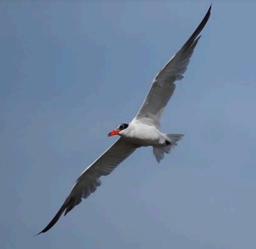
10th October
John Cantelo advised offering a prayer to the Virgin Mary to improve our chances of seeing sandgrouse (As an atheist this isn't something I often do but, in my experience, seeing sandgrouse here involves a lot of luck! - JC ) . We failed to do so, so failed on the sandgrouse, too. We had, however, left the hotel well before sunrise and driven to a suitable site outside Trebujena, as recommended by John, but there wasn’t a hint of a sandgrouse. There were compensations, including big flocks of calandra larks. We found a small freshwater wetland reserve with hides (locked so unusable) which had flamingoes and stilts, plus a solitary pochard and several little grebes. On our way home a dozen stone curlews flushed and gave us good flying views.
We weren’t on the road again until 10.30, retracing our early morning route, then carrying on to the Bonanza saltpans. As we drove we saw the expected birds on the floods of the Guadalquivir, including a variety of waders and an osprey. At the northern part of the saltpans we saw a good flock of lesser short-toed larks, their buzzing call highly distinctive. The track was now very rough, so we turned round and back to the Algaida pinewoods where I hoped to see azure-winged magpies. No luck. (NB - this is a traditional site for the magpies but they are now very hard to find here - JC) A hobby soaring overhead was the best bird, but there were a number of spotted flycatchers in the umbrella pines, where I also saw blue tits and Sardinian warblers.
We continued on along the rough road, with its fierce sleeping policemen, to the unattractive Algaida lagoon (Laguna de Tarelo - JC) , with its rather nasty reed-screen hide. There were hundreds of shovelers on the water, with hardly any of the drakes showing any sign of moulting into full plumage. There were also seven or eight white-headed ducks, while I managed to spot a trio of marbled teal at the farthest end of the lagoon, but the view was bad due to a combination of distance, heat haze and tall reeds blowing across the telescope lens. A bonus was a sighting of four black storks circling in the distance.
We ate our lunch in the woods, pestered by numerous small flies, before setting off to try and find the Lagunas de Camino Colorado. We found them eventually - two scruffy pools but with plenty of birds. The first held our first purple swamphen and a couple of Temminck’s stints that I eventually found, along with moorhens, coots and a couple of juvenile glossy ibises. I also had two brief views of a kingfisher. The second larger pool held a trio of marbled teal that showed well. These two small pools are surrounded by rubbish in an area of extremely intensive agriculture, but remarkably attract interesting birds.
We then drove into the Bonanza salt pans that, to my surprise, didn’t hold a lot of birds. There was the usual sprinkle of waders and flamingoes, but not much else. We paused near the Guadalquivir, a broad and mighty river here, and were rewarded when a fine Caspian tern came over, repeatedly hunting the same beat. A single black stork also appeared and dropped in on a wetland that also held a couple of feeding spoonbills, along with several grey herons, little egrets and flamingoes.
Our drive home was slow and at times painful, with the road rough and broken. We stopped again in the pinewoods but failed to see anything new, though we again saw a hobby (the same one as this morning?), plus a trio of red kites. Then it was back across the dried marismas, and back to base at 6.45.
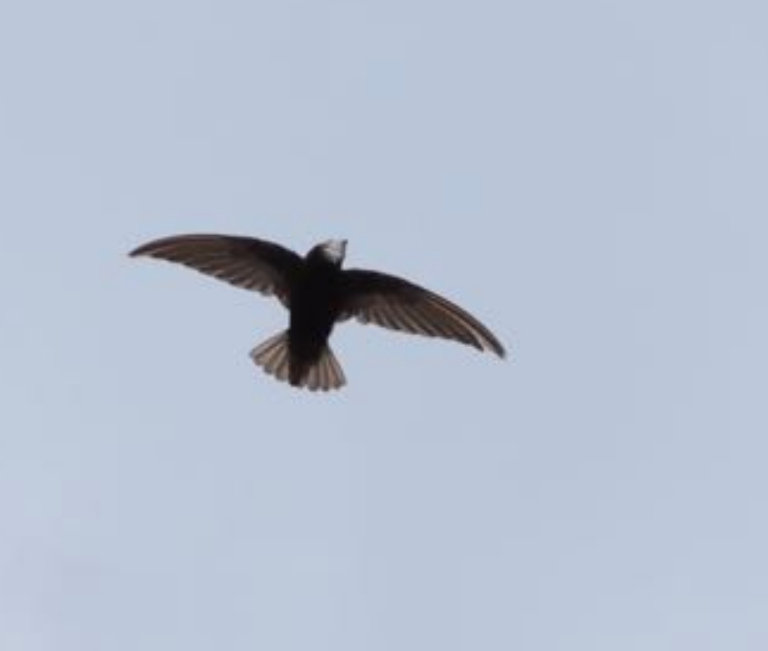
Breakfast in a noisy and popular local bar, with three televisions all showing the same news programme (with devastating floods in Valencia), started our day. We then drove south to Sanlucar, threading our way past the bodegas to the river front. Here there was ample parking, with fine views north across the mouth of the Guadalquivir towards Doñana and Huelva. A large expanse of sand was exposed, and the tide was falling fast, but few birds were visible. We continued south, stopping at two more viewpoints where we had a commanding view over the estuary. We heard, then saw, our first curlews of the trip, along with bar-tailed godwits, sanderlings, turnstones and ringed plovers. At one site, La Jara, an extensive rocky foreshore was exposed, and here we scoped a distant group of terns and gulls. I found our first Mediterranean gull, while there was a common tern with the Sandwich terns. The great majority of the gulls were lesser black-backed.
We continued on to Chipiona, winding our way through narrow streets until (with a little help from electronic devices) we eventually found the fish market, complete with several little swifts flying overhead. Most disappeared soon afterwards, but there were regular returns from pairs, some of which visited the nest sites under the low roof of the market. Photography was a challenge, but the pictures we did get showed that several of the birds were carrying feathers. The swifts here are resident, and are apparently double-brooded, though The Birds of the Iberian Peninsula suggests that the nesting season finishes in July. It clearly doesn’t. Out to sea I spotted a skua, which judging by its size and flight was an Arctic. Mike and Chris eventually saw two together.
We had our lunch on the beach next to an old castellated building, watching the gulls on the beach that waited hopefully for crumbs. Again, the majority were lesser black-backed, and most of them were immature birds. They are more athletic birds than the yellow-legged, with slightly shorter legs and slimmer bodies. Here sanderlings and turnstones were clearly used to people and very approachable. A trio of greenshanks landed noisily on the tideline: I managed to photograph two of them. I was tempted to explore the coast towards Rota, but it’s heavily built up with new holiday developments. (Note - the largest development here, the Costa Ballena, has a large park with ornamental pools which can be surprisingly good for birds, often hosting ring-billed gulls), We did stop once, walking to the beach where a gannet was seen offshore and a fine Mediterranean gull flew by. There were blackbirds in the bushes, but nothing to excite us, so we head back towards La Jara, as John’s email had told us that it was a good site for terns a couple of hours before high tide. Alas, the whole bay was now flooded, and there was nothing to see. We tried again a little closer to Sanlucar, but without success.
The Colorado pools weren’t far away, so we decided to have another look at this productive but unattractive site, and to find the third lake. We soon added a new bird - a drake pintail - and the Temminck’s stints were still to be seen. The third lake (which I hadn’t seen before) proved to be most productive. Here there were roosting night herons (at least a dozen), plus our first teal, which flew off. A pair of garganey ... and we enjoyed good views again of marbled teal. I checked out the coots carefully, but they were all the standard model. We also saw two or three swamphens, lots of moorhens, half a dozen very young flamingoes and a kingfisher. As we watched the sky darkened, thunder rumbled, and eventually it poured with rain, though it didn’t last long. It was time to head for home, a 35- minute drive.
We set off for the airport at 7.30 sharp. It was an easy drive on deserted roads (apparently because it was Spain’s National Day). Security was quiet and easy, but it was a long walk up to Gate 24 for our flight.
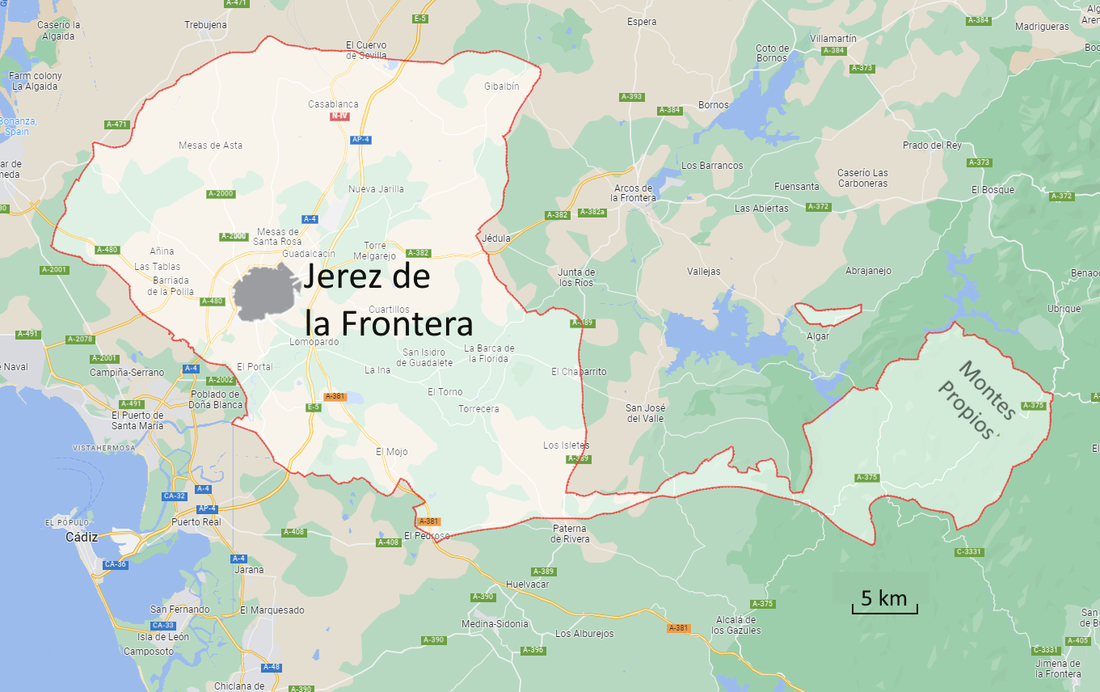
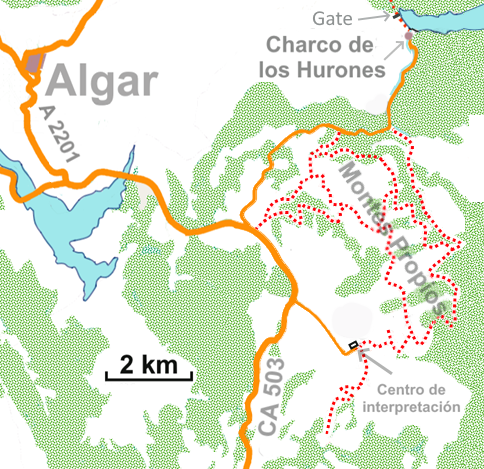
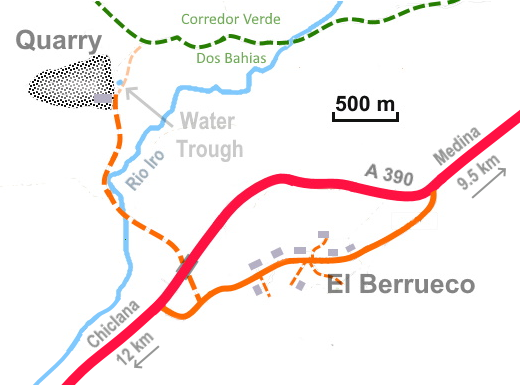
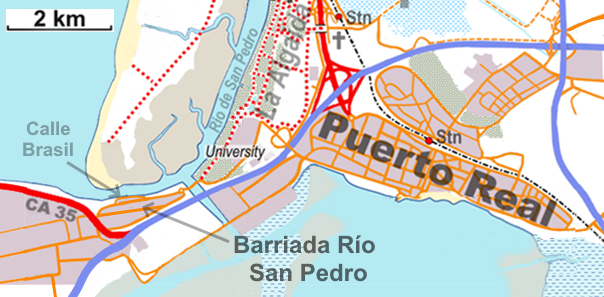
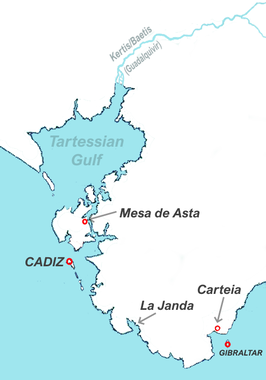
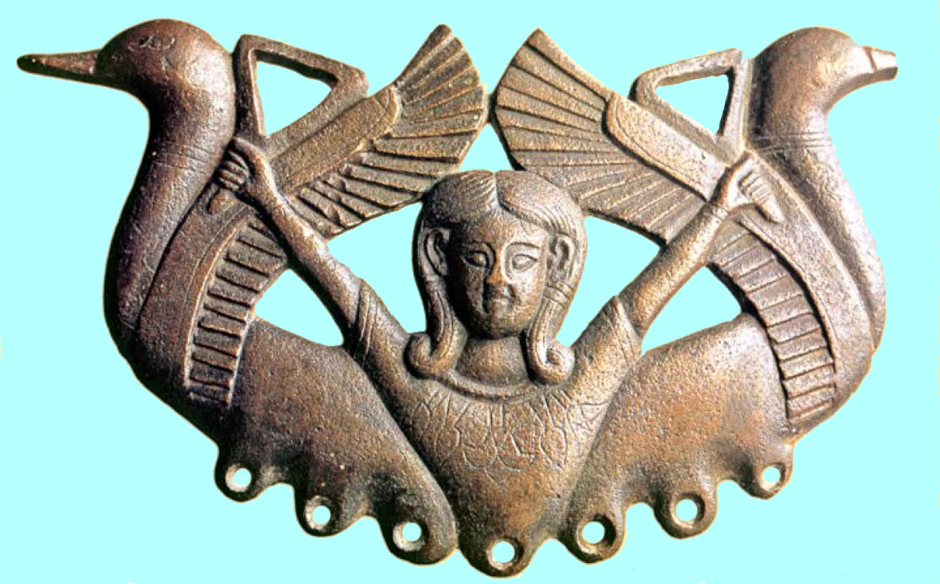
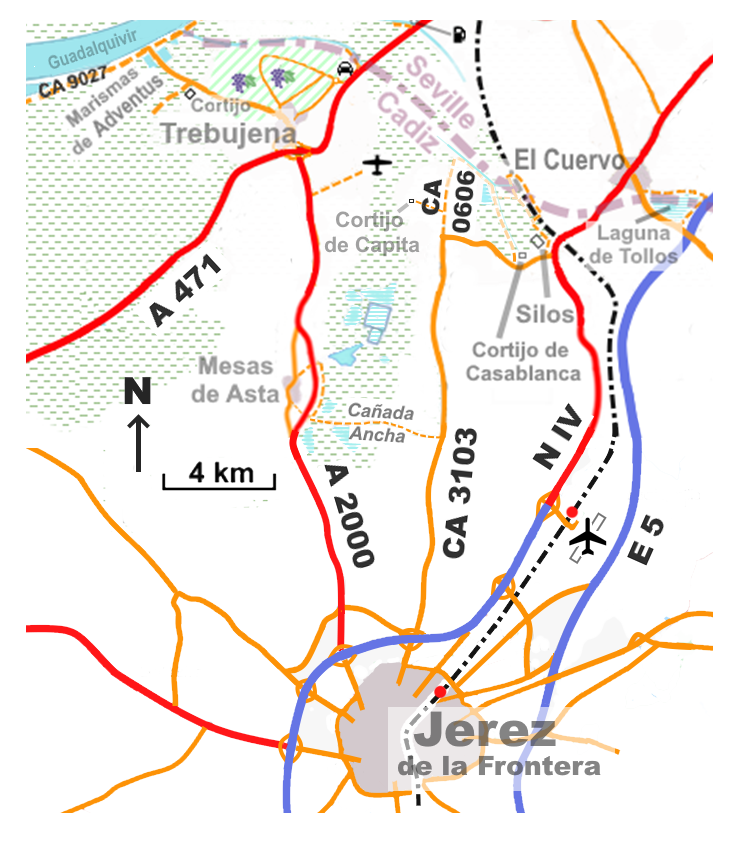
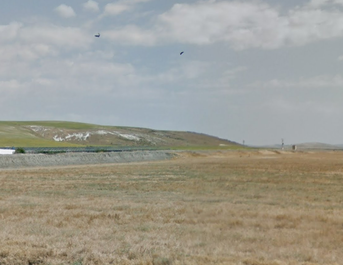
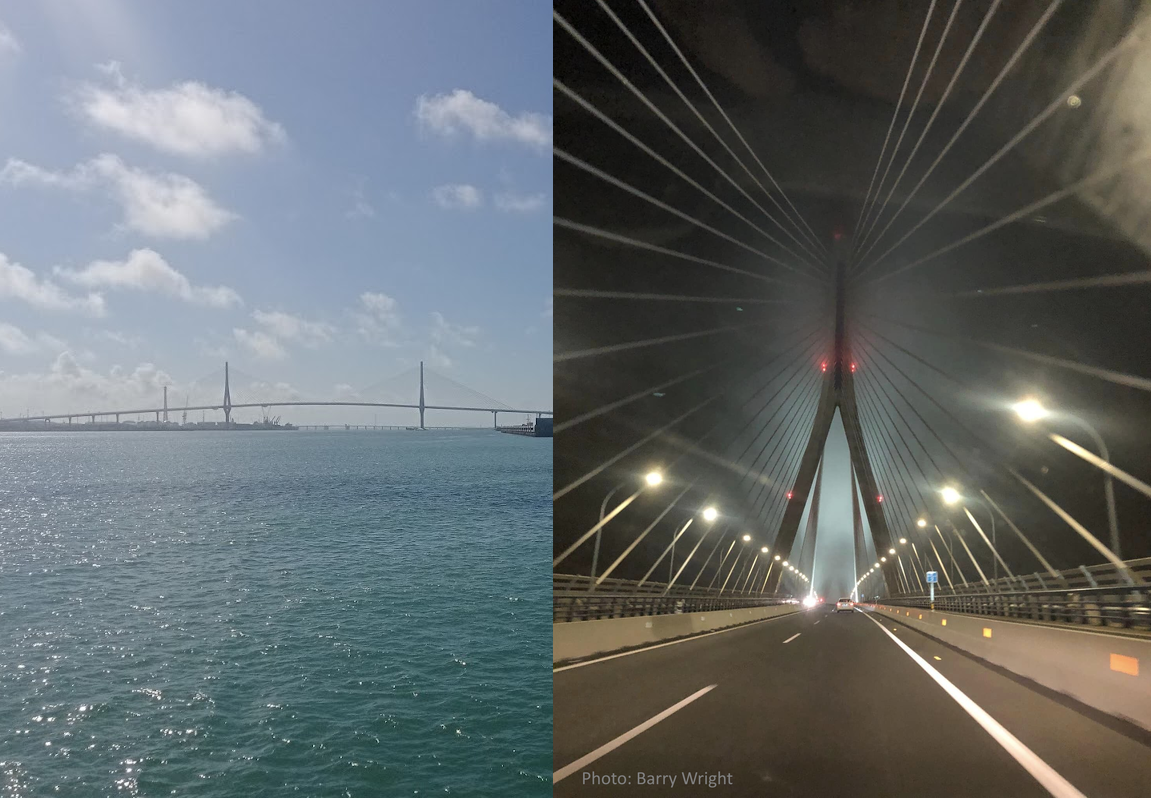
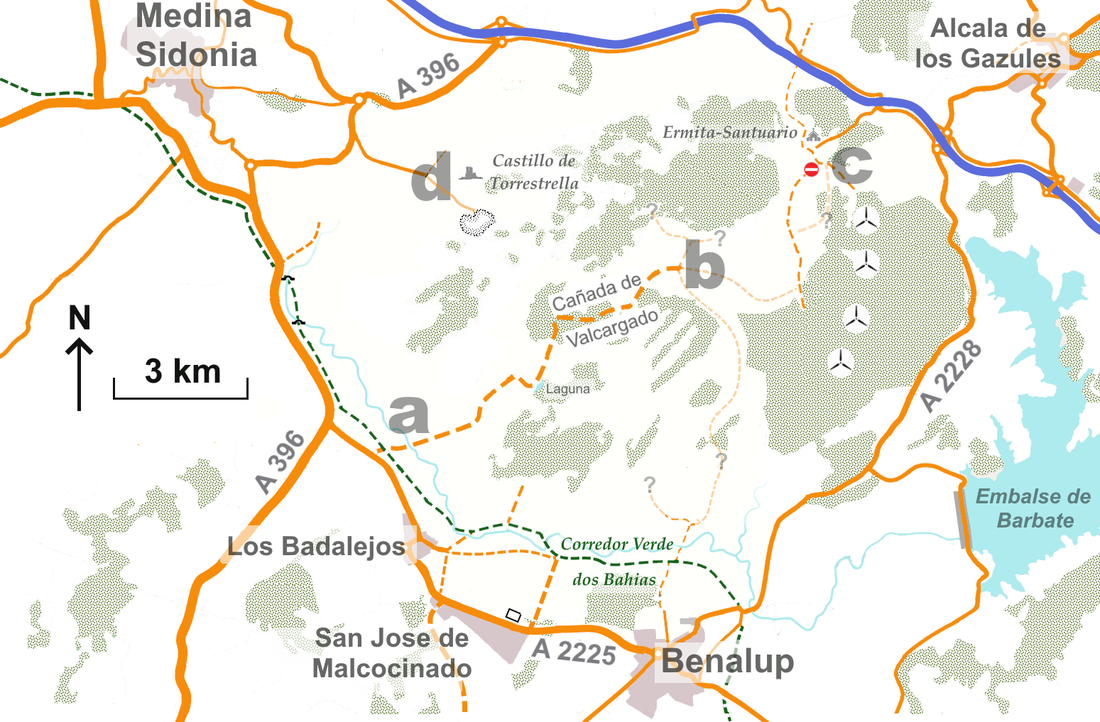
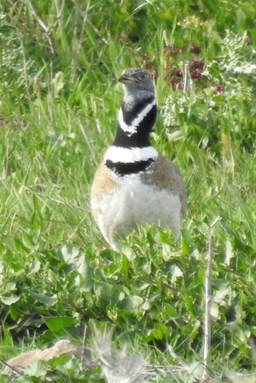
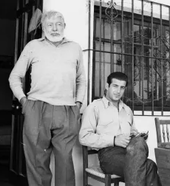
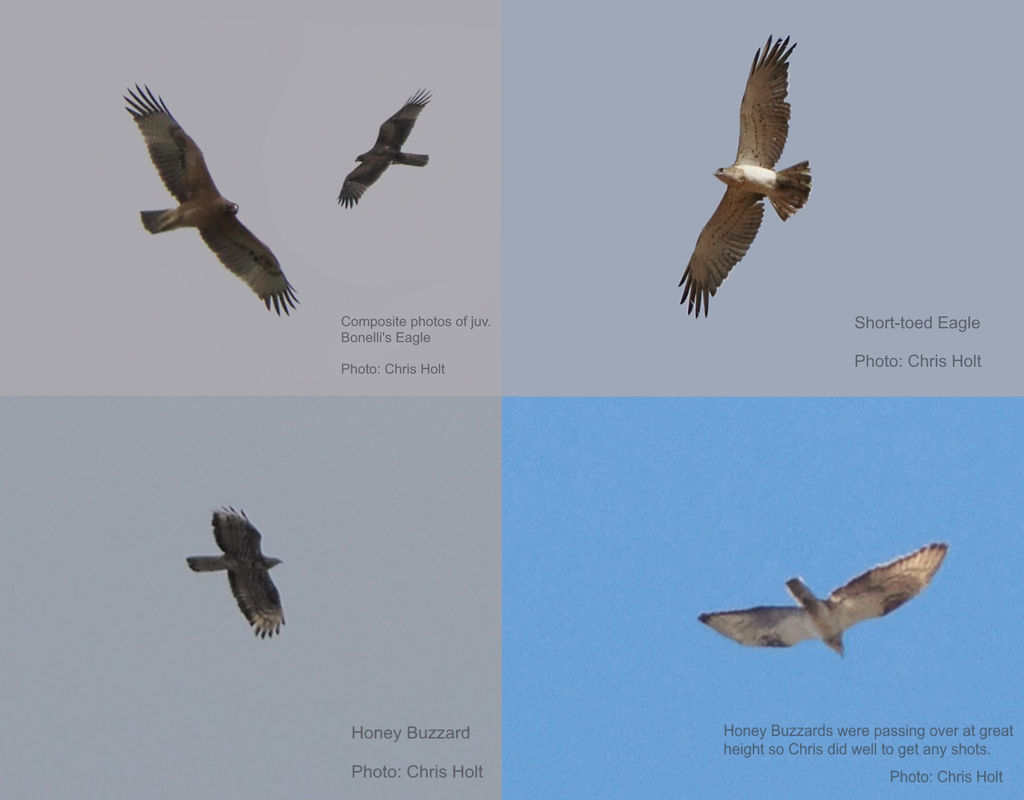
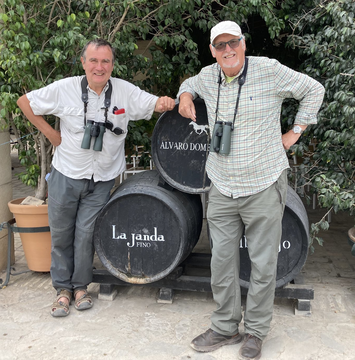
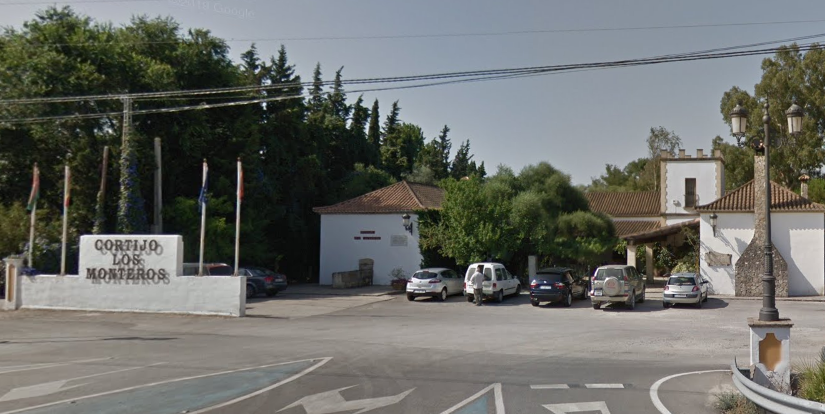
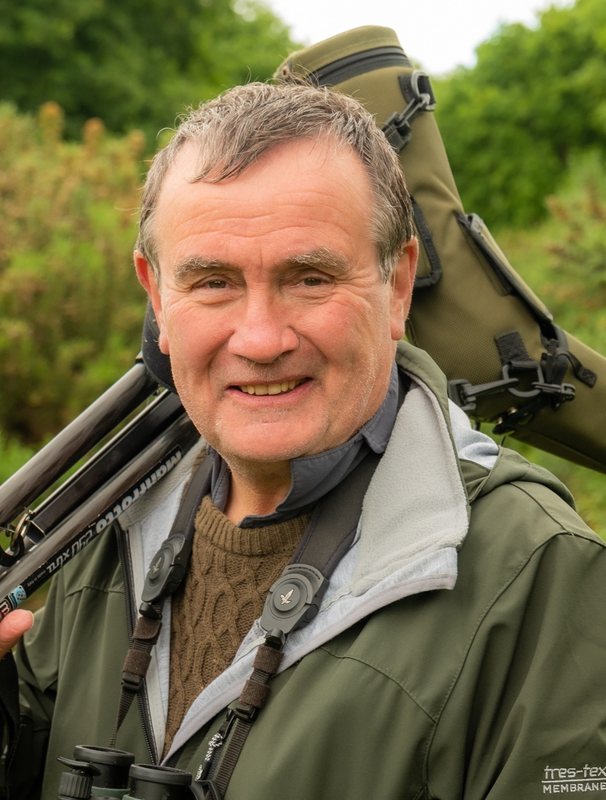
 RSS Feed
RSS Feed
